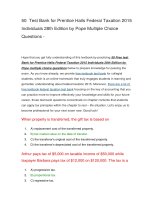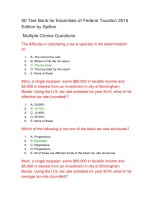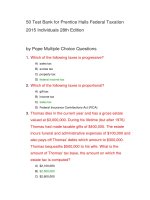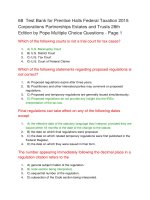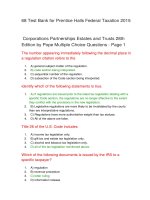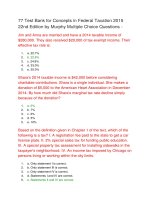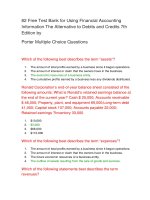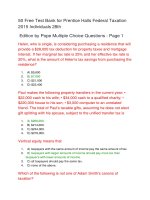Test bank for south western federal taxation 2015 corporations partnerships estates and trusts 38th edition
Bạn đang xem bản rút gọn của tài liệu. Xem và tải ngay bản đầy đủ của tài liệu tại đây (80.19 KB, 21 trang )
Test Bank for South Western Federal Taxation 2015
Corporations Partnerships Estates and Trusts 38th
Edition
Multiple Choice Questions
Regulations may first be found in:
1.
a. Federal Register.
2.
b. Cumulative Bulletin.
3.
c. Internal Revenue Bulletin.
4.
d. I.R.S. Digest.
5.
e. All of the above.
Which state is not a community property state?
1.
a. Arizona.
2.
b. Texas.
3.
c. New Mexico
4.
d. Virginia
5.
e. None of the above.
A decision in which of the following courts carries the lowest tax authority?
1.
a. U.S. Court of Appeals for the Federal Circuit.
2.
b. U.S. Court of Appeals for the Second Circuit.
3.
c. U.S. District Court.
4.
d. U.S. Supreme Court.
5.
e. U.S Court of Appeals Federal Circuit.
Which citation refers to a U.S. Court of Federal Claims decision?
1.
a. Apollo Computer, Inc. v. U.S., 951 USTC ¶ 50,015 (Fed. Cl., 1994).
2.
b. Westreco, Inc., T.C. Memo. 1992-561 (1992).
3.
c. Bausch & Lomb, Inc. v. Comm., 933 F. 2d 1084 (CA-2, 1991).
4.
d. Portland Manufacturing Co. v. Comm., 35 AFTR 2d 1439 (CA-9, 1975).
5.
e. None of the above.
Federal tax legislation generally originates in what body?
1.
a. Internal Revenue Service.
2.
b. Senate Finance Committee.
3.
c. House Ways and Means Committee.
4.
d. House Taxation Committee.
5.
e. None of the above.
Revenue Procedures are published in the:
1.
a. Congressional Record.
2.
b. Federal Revenue Bulletin.
3.
c. Internal Revenue Bulletin.
4.
d. I.R.S. Digest.
5.
e. None of the above.
Regarding technical advice memoranda, which statement is incorrect?
1.
a. Issued by the National Office of IRS.
2.
b. Most often deal with a completed transaction.
3.
c. May be cited and used as precedent.
4.
d. Issued with multi-digit file numbers.
5.
e. None are incorrect.
Which is a primary source of tax law?
1.
a. J.W. Yarbo v. Comm., 737 F. 2d 479 (CA-5, 1984).
2.
b. Article by a Federal judge in Harvard Law Review.
3.
c. Determination letter.
4.
d. Letter ruling.
5.
e. All of the above are primary sources.
Douglas and Sue, related parties, are landlord and tenant as to certain
business property. If the IRS questions the amount of rent Sue is paying to
Douglas, this is an illustration of the:
1.
a. Arm’s length concept.
2.
b. Continuity of interest concept.
3.
c. Tax benefit rule.
4.
d. Substance over form concept.
5.
e. None of the above.
Which of the following refers to a trial court rather than an appellate court
decision?
1.
a. Forgeus v. Comm., 6 B.T.A. 291 (1927).
2.
b. Farris v. Comm., 222 F.2d 320 (CA-10, 1955).
3.
c. Danville Plywood Corp., 899 F.2d 3 (Fed Cir. 1990).
4.
d. Boehm v. Comm., 326 U.S. 287 (1945).
5.
e. None of the above.
Which of these notations would appear after a U.S. Tax Court citation if the
IRS disagrees with the decision?
1.
a. Rev’d 935 F.2d 203 (1991).
2.
b. Nonacq. 1979-1 C.B. 1.
3.
c. Cert. den. 361 U.S. 875 (1959).
4.
d. Acq. 1990-1 C.B. 2.
5.
e. None of the above.
Which state is located in the jurisdiction of the Fifth Court of Appeals?
1.
a. Louisiana.
2.
b. California.
3.
c. New York.
4.
d. South Carolina.
5.
e. None of the above.
Which trial court normally has 16 judges?
1.
a. U.S. Tax Court.
2.
b. U.S. Court of Federal Claims.
3.
c. U.S. Supreme Court.
4.
d. U.S. Court of Appeals.
5.
e. None of the above.
Which citation refers to a Fourth Circuit Court of Appeals decision?
1.
a. 40 T.C. 1018.
2.
b. 2 TCM 205 (1951).
3.
c. 354 F.Supp. 1003 (D. Ct. Ga, 1972).
4.
d. 914 F.2d 396 (CA-3, 1990).
5.
e. None of the above.
Which statement is not true about this citation: Bonkowski v. Comm., 29 TCM
1645 (1970), aff’d 458 F.2d 709 (CA-7, 1972), cert. den.?
1.
a. The Supreme Court decided not to agree or disagree with the Seventh Court of
Appeals.
2.
b. The Seventh Court of Appeals disagreed with the Tax Court.
3.
c. The Tax Court decision starts on page 1645.
4.
d. The Seventh Court of Appeals decision appears in Vol. 458.
5.
e. All of the above.
Which of the following is an administrative source of tax law?
1.
a. Rev. Rul. 2010-19.
2.
b. Joint Conference Committee Report.
3.
c. Section 12(a) of the Internal Revenue Code.
4.
d. All of the above.
5.
e. None of the above.
Which citation refers to a Second Court of Appeals decision?
1.
a. 40 T.C. 1018.
2.
b. 159 F. 2d 848 (CA-2, 1947).
3.
c. 354 F. Supp. 1003 (D. Ct. Ga, 1972).
4.
d. 914 F. 2d 396 (CA-3, 1990).
5.
e. None of the above.
Interpret the following citation: 641 USTC ¶ 9618, aff’d in 344 F. 2d 966.
1.
a. A U.S. Tax Court Small Cases Division decision that was affirmed on appeal.
2.
b. A U.S. Tax Court decision that was affirmed on appeal.
3.
c. A U.S. District Court decision that was affirmed on appeal.
4.
d. A U.S. Court of Appeals decision that was affirmed on appeal.
5.
e. None of the above.
Which citation is considered to be a legislative citation?
1.
a. Ltr. Rul. 199952058.
2.
b. Ann. 94-5, 1994-2 I.R.B. 39.
3.
c. Reg. § 1.10141(c)(1).
4.
d. § 351.
5.
e. None of the above.
Which provision could best be justified as a means of controlling the
economy?
1.
a. Write-off of research and development expenditures.
2.
b. The § 179 immediate writeoff of depreciable capital expenditures.
3.
c. Amortization of pollution control facilities.
4.
d. The rehabilitation tax credit.
5.
e. None of the above.
A Memorandum decision of the U.S. Tax Court could be cited as:
1.
a. T.C. Memo. 1990-650.
2.
b. 681 USTC ¶ 9200.
3.
c. 37 AFTR 2d 456.
4.
d. All of the above.
5.
e. None of the above.
If these citations appeared after a trial court decision, which one means that
the decision was viewed favorably?
1.
a. Aff’d 633 F. 2d 512 (CA7, 1980).
2.
b. Rem’d 399 F. 2d 800 (CA5, 1968).
3.
c. Rev’d 914 F. 2d 396 (CA3, 1990).
4.
d. Rev’d 935 F. 2d 203 (CA5, 1991).
5.
e. None of the above.
In Forty-Four Cigar Co., 2 B.T.A. 1156, the 1156 stands for:
1.
a. The volume number.
2.
b. The year of the decision.
3.
c. The paragraph number.
4.
d. The page number.
5.
e. None of the above.
A Technical Advice Memorandum is issued by:
1.
a. Treasury Department.
2.
b. National Office of the IRS.
3.
c. Office of Chief Council.
4.
d. Area Director.
5.
e. None of the above.
Determine the incorrect citation:
1.
a. TAM 20002704.
2.
b. George W. Guill, 112 T.C. , No. 22 (1999).
3.
c. John H. Wong, T.C. Summary Opinion 2009-152.
4.
d. Rev. Rul. 98-32, 1998-25 I.R.B. 4.
5.
e. None of the above.
Which trial court’s jurisdiction depends on the geographical location of the
taxpayer?
1.
a. U.S. Tax Court.
2.
b. U.S. District Court.
3.
c. U.S. Court of Federal Claims.
4.
d. Small Cases Division of the Tax Court.
5.
e. None of the above.
Which trial court decision is generally less authoritative?
1.
a. U.S. District Court.
2.
b. U.S. Tax Court.
3.
c. U.S. Court of Federal Claims.
4.
d. Small Cases Division of the Tax Court.
5.
e. All of the above are the same.
Which of the following statements about an acquiescence is correct?
1.
a. An acquiescence is issued in the Federal Register.
2.
b. Acquiescences are published only for certain regular decisions of the U.S. Tax
Court.
3.
c. An acquiescence is published in the Internal Revenue Bulletin.
4.
d. The IRS does not issue acquiescences to adverse decisions that are not appealed.
5.
e. All of the above are correct.
Which of the following sources has the highest tax validity?
1.
a. Treasury Regulation.
2.
b. Revenue Procedure.
3.
c. Internal Revenue Code.
4.
d. Temporary Regulation.
5.
e. All have the same weight.
Which provision could best be justified as encouraging small business?
1.
a. Ordinary loss allowed on § 1244 stock.
2.
b. Percentage depletion.
3.
c. Domestic production activities deduction.
4.
d. Interest deduction on home mortgage.
5.
e. None of the above.
Which provision is not justified by social considerations?
1.
a. Refundable earned income credit.
2.
b. Adoption tax credit.
3.
c. Like-kind exchange treatment.
4.
d. Disallowance of illegal kickbacks.
5.
e. None of the above.
Which court decision is generally more authoritative?
1.
a. A U.S. Tax Court decision.
2.
b. Court of Federal Claims decision.
3.
c. District Court decision.
4.
d. U.S. Court of Appeals decision.
5.
e. U.S. Tax Court Memorandum decision.
True False Questions
Proposed Regulations have the force and effect of law.
1.
True
2.
False
Revenue Rulings carry the same legal force and effect as Regulations.
1.
True
2.
False
In a U.S. District Court, a jury can decide both questions of fact and questions
of law.
1.
True
2.
False
Since interest and taxes are deductible by a homeowner, a person who rents
an apartment may take an itemized deduction equal to 20% of rent payments.
1.
True
2.
False
Some Regulations are arranged in different sequence than the Code.
1.
True
2.
False
Appeals from the Court of Federal Claims go to the U.S. Supreme Court.
1.
True
2.
False
Internal Revenue Code § 6 involves gross income and § 7 outlines itemized
deductions.
1.
True
2.
False
Determination letters usually involve proposed transactions.
1.
True
2.
False
Although a corporation is subject to a Federal income tax, a partnership is
not.
1.
True
2.
False
The domestic production activities deduction is structured so as to create
jobs.
1.
True
2.
False
One Code section enables shareholders in a small business corporation to
obtain an ordinary deduction for any loss recognized on a stock investment.
1.
True
2.
False
A jury trial is available in a Court of Appeals situation.
1.
True
2.
False
When there is a direct conflict between a Code section and a treaty provision,
the most recent item takes precedence.
1.
True
2.
False
Revenue Procedures deal with the internal management practices and
procedures of the IRS.
1.
True
2.
False
A U.S. District Court must abide by the precedents set by the Court of Appeals
of its jurisdiction.
1.
True
2.
False
These Internal Revenue Code citations are incorrect: § 212(1) and § 1221(1).
1.
True
2.
False
A Revenue Ruling is a legislative source of Federal tax law.
1.
True
2.
False
Subchapter P refers to the subchapter in the Internal Revenue Code that deals
with partners and partnerships.
1.
True
2.
False
The U.S. Federal government has a provision in the Constitution which
precludes deficit spending.
1.
True
2.
False
“Legislative regulations” are stronger than “interpretative” regulations.
1.
True
2.
False
Only one judge hears a trial in a U.S. District Court.
1.
True
2.
False
The encouragement of private-sector pension plans can be justified under the
encouragement of certain industries.
1.
True
2.
False
Alabama and South Carolina are community property states.
1.
True
2.
False
Revenue-neutral tax laws reduce deficits.
1.
True
2.
False
Many states have balanced budgets because laws or constitutional
amendments preclude deficit spending.
1.
True
2.
False
Treasury Decisions are issued by the Treasury Department to promulgate new
Regulations.
1.
True
2.
False
Taxpayers may look at Committee Reports to determine the intent of
Congress.
1.
True
2.
False
A tax bill cannot originate in the Senate Finance Committee.
1.
True
2.
False
Temporary Regulations have the same authoritative value as Finalized
Regulations for 4 years.
1.
True
2.
False
Longer class lives for depreciable property and the required use of straightline method of depreciation should dampen the tax incentive for purchasing
capital assets.
1.
True
2.
False
Proposed Regulations are not published in the Federal Register.
1.
True
2.
False
The Golsen rule has been overturned.
1.
True
2.
False
The Federal tax law allows a taxpayer to claim a deduction for state and local
income taxes.
1.
True
2.
False
Unlike determination letters, letter rulings are issued by the National Office of
the IRS.
1.
True
2.
False
Regulations are issued by the Treasury Department.
1.
True
2.
False
The Internal Revenue Code is a compilation of Federal tax legislation that
appears in Title 26 of the United States Code.
1.
True
2.
False
A taxpayer must pay any tax deficiency assessed by the IRS and sue for a
refund to bring suit in the U.S. District Court.
1.
True
2.
False
Free Text Questions
What is the value of Actions on Decisions to a tax researcher?
Answer Given
Actions on Decisions tell a taxpayer the IRS’s reaction to certain court decisions. The
IRS follows a practice of either acquiescing (agreeing) or nonacquiescing (not
agreeing) with court decisions where guidance may be helpful. This practice does not
mean that a particular decision has no value if the IRS has nonacquiesced in the
result. It does, however, indicate that the IRS will continue to litigate the issue
involved.
Explain the Golsen doctrine.
Answer Given
Because the Tax Court is a national court, it decides cases from all parts of the
country. For many years, the Tax Court followed a policy of deciding cases based on
what it thought the result should be, even though its decision might be appealed to a
U.S. Circuit Court of Appeals that had previously decided a similar case differently. A
number of years ago this policy was changed in the Golsen decision. Now the Tax
Court will decide a case as it feels the law should be applied only if the Circuit Court of
Appeals of appropriate jurisdiction has not yet passed on the issue or has previously
decided a similar case in accord with the Tax Court’s decision. If the Circuit Court of
Appeals of appropriate jurisdiction has previously held otherwise, the Tax Court will
conform under the Golsen rule even though it disagrees with the holding.
What value is a tax citator to a tax researcher?
Answer Given
The use of manual citators or a computer citator search is invaluable to tax research.
A citator provides the history of a case including the authority relied on (e.g., other
judicial decisions) in reaching the result. Reviewing the references listed in the citator
discloses whether the decision was appealed and, if so, with what result (e.g.,
affirmed, reversed, and remanded). It also reveals other cases with the same or similar
issues and how they were decided. Thus, a citator reflects on the validity of a case and
may lead to other relevant judicial material.
How does a treaty with a foreign country impact a section in the Internal
Revenue Code?
Answer Given
The United States enters into tax treaties (sometimes called tax conventions) with
foreign countries to render mutual assistance in tax enforcement and to avoid double
taxation. Neither a tax law or tax treaty takes precedence. When there is a conflict, the
most recently enacted item will take precedence.
What impact has the community property system had on our Federal tax
laws?
Answer Given
The position of the residents of community property states was so advantageous that
many common law states actually adopted community property systems. The political
pressure placed on Congress to correct the disparity in tax treatment was
considerable. To a large extent, this correction was accomplished in the Revenue Act
of 1948, which extended many of the community property tax advantages to residents
of common law jurisdictions. Thus, common law states avoided the trauma of
discarding their time-honored legal system familiar to everyone. The impact of
community property law on the Federal estate and gift taxes is further explored in
Chapters 17 and 18.
